#Apache Warrior
Explore tagged Tumblr posts
Text

#Apache#Apache Warrior#the Apache#deadliest warrior#spike tv#could infinity train have saved them poll#could infinity train have saved them
2 notes
·
View notes
Text

Geronimo and his warriors. One of the only known photos of Indian combatants still in the field who had not yet surrendered to the United States. C. S. Fly, March 1886. (source)
47 notes
·
View notes
Text

#beyond the adobe#western style#cowboy life#santa fe#ranch life#southwestern#western living#plains indian war horse#war pony#apache warriors
80 notes
·
View notes
Text

Thinking about her the other day
#navii art#my art#sth fanart#archie sonic#lupe the wolf#satam sonic#for my design i want to explore first how i would draw her as seen in the comics/show#then how i can incorporate more representative elements of her inspiration- buckskin textiles and patterns from her armor in the comics#then finally what i think would be 'easier' to draw in a comic setting- simpler design and shapes that takes less time and fits modern style#i primarily used mescalero apache peoples as reference- esp their buckskin textiles but also included patterns from her armor in the comics#she and the wolf pack were more of a monolithic representation of indigenous peoples in the americas then representing a specific population#though her armor always threw me off- maybe a mix between greek and mesoamerican? made me think too much of an amazonian warrior#and away with the leotards
32 notes
·
View notes
Photo




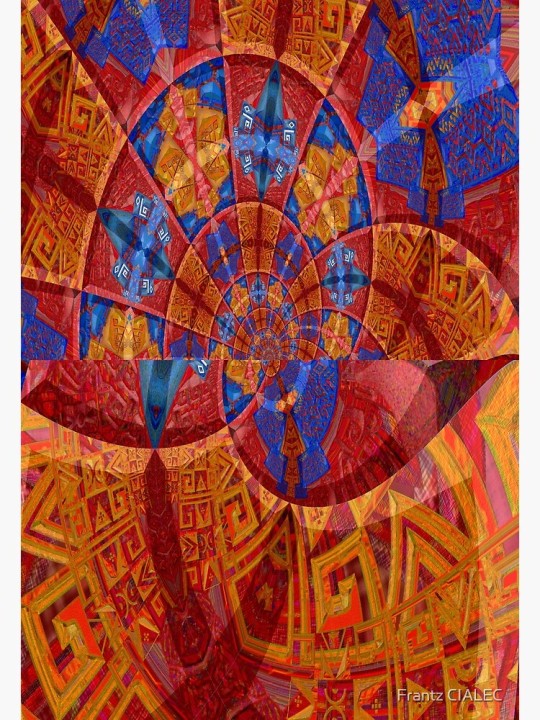
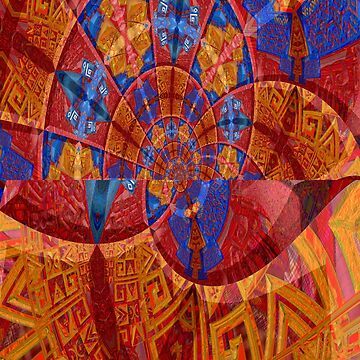




(via " BLUE RED YELLOW ABSTRACT PAINTING NATIVE AMERICAN TRIBAL ART PATTERN " Metal Print for Sale by Frantz CIALEC)
Hello you 🤗 Sharing with you another newborn of my wonderful native American designs collection. "BLUE RED YELLOW ABSTRACT PAINTING NATIVE AMERICAN TRIBAL ART PATTERN" Discover the vibrant spirit of Native American culture through our unique design, “Blue Red Yellow Abstract Painting Native American Tribal Art Pattern”. This artwork is a celebration of the rich and diverse heritage of Native American tribes, encapsulating their profound connection to nature and their ancestral roots. The abstract pattern, a harmonious blend of blue, red, and yellow, is inspired by traditional tribal art. The blue symbolizes the vast sky and the tranquil waters that have nurtured life for centuries. The red represents the earth, echoing the deep bond between Native Americans and the land they cherish. The yellow signifies the radiant sun, a universal symbol of life and energy in many Native American cultures. This design is more than just an aesthetic choice; it’s a tribute to the resilience and wisdom of Native American tribes. Each color, each pattern tells a story - stories of courage, unity, and respect for all living beings. It’s an invitation to delve deeper into these rich narratives and gain a newfound appreciation for this remarkable culture. By choosing this design, you’re not just making a style statement. You’re acknowledging the invaluable contributions of Native American tribes to our shared history and promoting cultural understanding. Experience the beauty of diversity with our “Blue Red Yellow Abstract Painting Native American Tribal Art Pattern”. Hve a wonderful Monday!!🙂😎 Happy international Native American Day Stay tuned,
#findyourthing#redbubble#art vs artist#raleksd#nativeamericans#navajo#chief#totem#american indain#native#warrior apache#feathers#indigenous#nativepatterns#blueredyellow#abstract#inca#tribal art#traditional art
0 notes
Text
Apache Warrior and Chieftain Victorio, One of the Most Notable Native Military Tacticians of all Time, Dies at the Battle of Tres Castillos in the Tres Castillos Mountains South of El Paso, Texas. October 15, 1880.
Image: Victorio (Public Domain) On this day in history, October 15, 1880, Apache warrior and chieftain Victorio, one of the most notable native military tacticians of all time, dies at the Battle of Tres Castillos in the Tres Castillos Mountains south of El Paso, Texas. The battle also resulted in the death or capture of most of his close to 200 followers. The clash ended Victorio’s War, a…

View On WordPress
#Apache warrior and chieftain Victorio#Battle of Tres Castillos#event & history#History Daily#Native Americans#Victorio&039;s War
1 note
·
View note
Text

0 notes
Photo

Geronimo
Geronimo (Goyahkla, l. c. 1829-1909) was a medicine man and war chief of the Bedonkohe tribe of the Chiricahua Apache nation, best known for his resistance against the encroachment of Mexican and Euro-American settlers and armed forces into Apache territory and as one of the last Native American leaders to surrender to the United States government.
During the Apache Wars (1849-1886), he allied with other leaders such as Cochise (l. c. 1805-1874) and Victorio (l. c. 1825-1880) in attacks on US forces after Apache lands became part of US territories following the Mexican-American War (1846-1848). Between c. 1850 and 1886, Geronimo led raids against villages, outposts, and cattle trains in northern Mexico and southwest US territories, often striking with relatively small bands of warriors against superior numbers and slipping away into the mountains and then back to his homelands in the region of modern-day Arizona and New Mexico.
He surrendered to US authorities three times, but when the terms of his surrender were not honored, he escaped the reservation and returned to launching raids on settlements. He was finally talked into surrendering for good by First Lieutenant Charles B. Gatewood (l. 1853-1896), under the command of General Nelson A. Miles (l. 1839-1925), in 1886. None of the terms stipulated by Miles were honored, but by that time, Geronimo felt he was too old and too tired to continue running. Geronimo's surrender to Gatewood is told accurately, though with some poetic license, in the Hollywood movie Geronimo: An American Legend (1993).
Geronimo was imprisoned at Fort Pickens, Pensacola, Florida, before being moved to Fort Sill, Oklahoma. Toward the end of his life, he became a sensation at the St. Louis World's Fair (1904) and President Theodore Roosevelt's Inaugural Parade (1905) as well as other events. Although one of the stipulations of his surrender was his return to his homelands in Arizona, he was held as a prisoner elsewhere for 23 years before dying in 1909 of pneumonia at Fort Sill.
Name & Youth
His Apache name was Goyahkla ("One Who Yawns"), and, according to some scholars, he acquired the name Geronimo during his campaigns against Mexican troops, who would appeal to Saint Jerome (San Jeronimo in Spanish) for assistance. This was possibly Saint Jerome Emiliani (l. 1486-1537), patron of orphans and abandoned children, not the better-known Saint Jerome of Stridon (l. c. 342-420), translator of the Bible into the Vulgate and patron of translators, scholars, and librarians.
Geronimo was born near Turkey Creek near the Gila River in the region now known as Arizona and New Mexico c. 1825. He was the fourth of eight children and had three brothers and four sisters. In his autobiography, Geronimo: The True Story of America's Most Ferocious Warrior (1906), dictated to S. M. Barrett, Geronimo described his youth:
When a child, my mother taught me the legends of our people; taught me of the sun and sky, the moon and stars, the clouds, and storms. She also taught me to kneel and pray to Usen for strength, health, wisdom, and protection. We never prayed against any person, but if we had aught against any individual, we ourselves took vengeance. We were taught that Usen does not care for the petty quarrels of men. My father had often told me of the brave deeds of our warriors, of the pleasures of the chase, and the glories of the warpath. With my brothers and sisters, I played about my father's home. Sometimes we played at hide-and-seek among the rocks and pines; sometimes we loitered in the shade of the cottonwood trees…When we were old enough to be of real service, we went to the field with our parents; not to play, but to toil.
(12)
After his father died of illness, his mother did not remarry, and Geronimo took her under his care. In 1846, when he was around 17 years old, he was admitted to the Council of Warriors, which meant he could now join in war parties and also marry. He married Alope of the Nedni-Chiricahua tribe, and they would later have three children. Geronimo set up a home for his family near his mother's teepee, and as he says, "we followed the traditions of our fathers and were happy. Three children came to us – children that played, loitered, and worked as I had done" (Barrett, 25). This happy time in Geronimo's life would not last long, however.
Continue reading...
158 notes
·
View notes
Text
This year, one day is NOT ENOUGH!
So to kick off Transgender Day of Visibility early, alongside Women’s History Month I encourage you to learn about Lozen, the two-spirited transmasculine warrior who loved and won the heart of Dahteste.
The love story of Lozen, a female bodied warrior who those closest to them would describe as more masculine than the men in the tribe. Never married, Lozen fell in love with another female warrior named Dahteste who although married and had kids, openly loved and fought alongside Lozen. Dahteste outlived Lozen and is described to have mourned Lozen till death. There is one photo I can find of them together, and they have been captured after the U.S. Army negotiated the surrender of Goyatla, a.k.a. Geronimo.

I’m still learning, all month, about historical women and transgender people of the past. Let’s learn together. ❤️
Here are some good reads/references where I’ve been learning about Lozen & Dahteste.
My personal Fav: https://leeparattner.org/learn/lrmahome-online-programs/womens-history-month-2021/
Happy Women’s History Month and Happy Transgender Day of Visibility! ❤️
-Elisha Alexzander
#trans day of visibility#two spirit#native american culture#womens history month#Lozen & Dahteste#lgbtq#transgender#transmaculine#lesbian#trans
95 notes
·
View notes
Text
Dahteste was a famous Apache woman warrior, and it was widely known that she could out-ride, out-shoot, out-hunt, out-run, and out-fight her peers, both male and female. She took part in battles and raiding parties alongside her husband and best friend Lozen, another Apache woman warrior. She and Lozen were good friends with Geronimo, and he chose her to be his official translator in his talks with the US Cavalry. After negotiating treaties with the US government, she was imprisoned in Alabama and Florida, and later, Fort Sill, surviving both tuberculosis and pneumonia. 19 years later, she was released and lived out the rest of her life on the Mescalero Apache reservation.
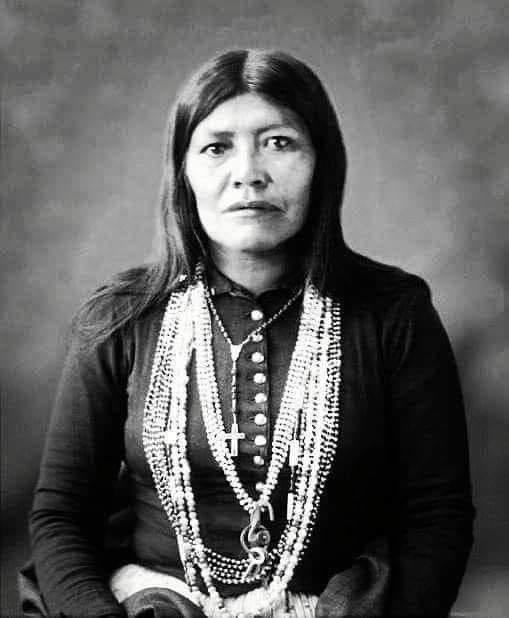
252 notes
·
View notes
Text

Gouyen was born in 1857 into the Chihenne band of the Chiricahua Apache. Her name, Góyą́ń, means "The One Who Is Wise" or "Wise Woman."
A legendary story of her bravery has been passed down in Apache history. After her husband was killed in a Comanche raid, Gouyen sought revenge. Disguising herself in a ceremonial buckskin dress, she infiltrated the enemy's camp during their victory dance. She seduced the Comanche chief responsible for her husband’s death, lured him away, and killed him. She then scalped him, took his breechcloth and moccasins, and presented these to her husband's parents as proof of her vengeance.
In 1880, during Victorio's campaign along the U.S.-Mexico border, the Chiricahua Apache were attacked at Tres Castillos, New Mexico. Victorio and 78 others were killed, including Gouyen's baby daughter. Only Gouyen, her young son Kaywaykla, and a few others escaped.
She later married Kaytennae, an Apache warrior who also survived the Battle of Tres Castillos. Together, they joined Nana and Geronimo in their resistance against U.S. forces. While on the run in 1883, Gouyen saved Kaytennae’s life by killing an enemy attempting to ambush him.
In 1886, when Geronimo and his followers were captured by the U.S. Army, Gouyen and her family were taken prisoner and sent to Fort Sill, Oklahoma, where she lived until her death in 1903.
A true warrior and symbol of Apache resilience, Gouyen’s legacy remains an inspiration.
28 notes
·
View notes
Text
The Warriors: A Forgotten Tribute to the Lenape and the Fight Against Erasure
When you think about The Warriors, the immediate image is that of street gangs battling for survival in a gritty, neon-lit New York City. But beneath the surface of baseball bats and leather vests lies a fascinating connection often overlooked: the deep ties to Indigenous American culture—specifically, the Lenape people, the original inhabitants of what we now call New York City.
The Warriors themselves, with their tribal structure, distinct identity, and fierce loyalty, are more than just a fictional gang. They echo the history, culture, and ultimate betrayal of the Lenape, who called Manhattan (originally “Manahatta,” meaning “many hills”) and the surrounding boroughs home long before colonizers arrived. This isn’t just conjecture—there are deliberate, undeniable parallels between the film’s story and the legacy of Indigenous resistance, survival, and erasure.
The Tribes of New York City
In The Warriors, each gang represents a unique tribe, hailing from different parts of the city and maintaining their own identity. This mirrors the structure of the Lenape, who were divided into three main groups based on dialect and geography:
Munsee: The northernmost group, encompassing Manhattan and the Bronx.
Unami: The central group.
Unalachtigo: The southernmost group.
These groups formed the “original boroughs” long before modern-day New York. The Lenape weren’t just skilled survivalists; they were visionaries. They cultivated one of the first extensive trade networks among Indigenous Americans, trading goods like corn, beans, and squash—the “Three Sisters”—that sustained entire communities.
Their governance, which often elevated women as leaders, was progressive even compared to European settlers. And their culture, which prioritized collaboration and open exchange with neighbors, laid the foundations for what would become one of the world’s most interconnected cities.
From Community to Colonization
The Lenape were initially friendly and open to the Dutch and British colonizers, even allowing them to interact with their culture. Early European settlers were stunned by how “civilized” the Lenape were, a stark contrast to the stereotypes they’d carried across the Atlantic.
But this openness became their undoing. The colonizers tricked the Lenape into forfeiting their lands, assuming they’d remain neighbors. Instead, the Europeans unleashed waves of violence—massacres, displacement, and the eventual eradication of the Lenape from their homeland. By the 1830s, policies like the Indian Removal Act solidified the erasure, forcing survivors to reservations far from their ancestral lands.
The echoes of this history resonate throughout The Warriors. The summit meeting called by Cyrus, the charismatic leader of the Gramercy Riffs, feels eerily similar to the council meetings held by Indigenous tribes to solve disputes or form alliances. Even Cyrus herself, with her vision of uniting the gangs against a common oppressor, channels the spirit of leaders like Chief Tamanend, a Lenape elder who sought peace and collaboration.
Colonial Parallels in the Film
Cyrus’s assassination by a white gang member and the ensuing chaos mirrors the betrayal faced by Indigenous leaders who sought to unify their people only to be struck down by colonial forces. The marginalization of the Warriors by other gangs parallels how colonizers manipulated and divided Indigenous groups, pitting them against each other to maintain control.
Even the Warriors’ names carry weight. Cochise, for instance, shares her name with the famed Apache chief who resisted European colonization. The name, meaning “hardwood,” symbolizes resilience—a fitting trait for a character fighting for survival in a hostile world.
And then there’s Luther, the maniacal leader of the Rogues, whose unprovoked violence against the Warriors feels like a microcosm of colonial aggression. His cries for destruction and his invasion of their turf reflect the terror inflicted upon Indigenous people simply for existing in lands others sought to claim.
The Warriors as a Modern Indigenous Legacy
What makes The Warriors so powerful, even decades later, is its ability to bridge the ancient past with the struggles of modern marginalized communities. The Lenape may have been displaced, but their culture is embedded in New York City’s DNA. From the very name “Manhattan” to Broadway itself (originally Lenape land), their influence endures.
The Warriors’ fight for survival, their solidarity in the face of overwhelming odds, and their refusal to be erased all echo the resilience of the Lenape and Indigenous peoples across the Americas. Cyrus’s vision of unity, though tragically cut short, symbolizes the enduring spirit of collaboration and resistance.
No matter how much history tries to erase the Lenape, their legacy lives on—in the landmarks they named, the practices they pioneered, and yes, even in the cultural touchstones like The Warriors. Just as the Warriors’ chant—“Come out to play!”—lingers in pop culture, so too does the Lenape’s influence, quietly reminding us of a people who refused to be forgotten.
The fight isn’t over. The Lenape’s descendants live on, their stories waiting to be told. It’s up to us to ensure those stories aren’t just remembered but celebrated—because history, much like the Warriors themselves, is always fighting to survive.
#warriors musical#lin manuel miranda#eisa davis#colonization#us imperialism#oppression#Man it's crazy this stuff they packed into this concept album.
27 notes
·
View notes
Text

Two Guns Arizona along Route 66 - infamous for its connection to the Apache Death Cave, where, according to legend, Navajo warriors trapped and killed a group of Apaches in 1878.
Now rumored to be cursed as every business venture at the site have mysteriously failed. Today, Two Guns stands as an eerie relic of Arizona’s past, attracting urban explorers and ghost hunters intrigued by its haunted history.
31 notes
·
View notes
Text

#beyond the adobe#santa fe#western living#boho western#southwestern#plains indians#war horse#apache warriors
114 notes
·
View notes
Text
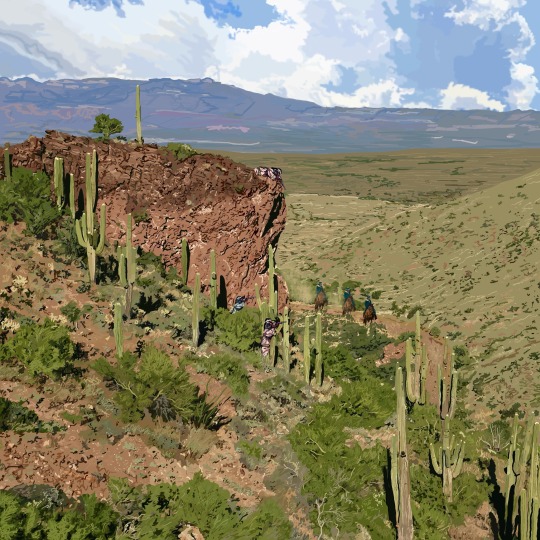
This is the fifth episode in the series over the Apache Indians in the American Southwest. This episode covers the aftermath of the Camp Grant Massacre and encompasses the years 1870 to 1874. It also continues the story of the most feared Apache warrior chief to have ever lived in the eyes of the Americans: Cochise.
The episode introduces important men of history in the region like General Crook, General Howard, Captain Tom Jeffords, Cochise’s sons Taza and Naiche, the Tonto Apache chief Red Ant (Delshay), the various Apache Scout leaders like Al Sieber, and countless others. Lieutenant Bourke, Geronimo, Merejildo Grijalva, and Mickey Free the kidnapped boy who started this long war also make heavy return appearances. The massive offensive against the Apaches and Yavapai Indians during the winter of 1872 to 1873 is discussed in detail as well as the flip side of the Indians Wars: President Grant’s “Peace Policy”.
Battles ensue, bureaucrats meddle, reservations are established, massacres like the Skeleton Cave Massacre blight the land, but by the end of the episode peace will reign, however briefly, on Apacheria.
38 notes
·
View notes
Photo
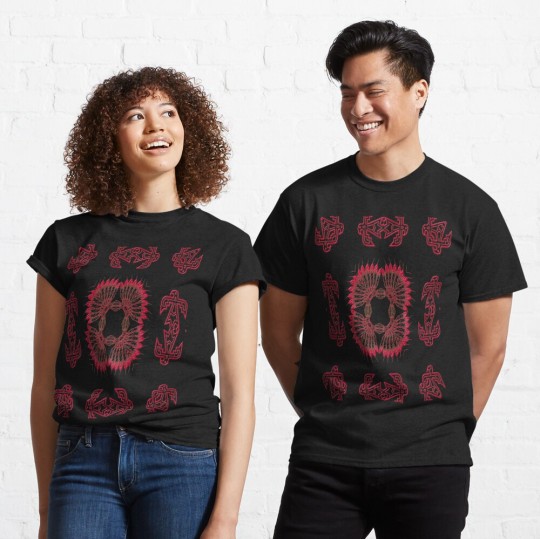







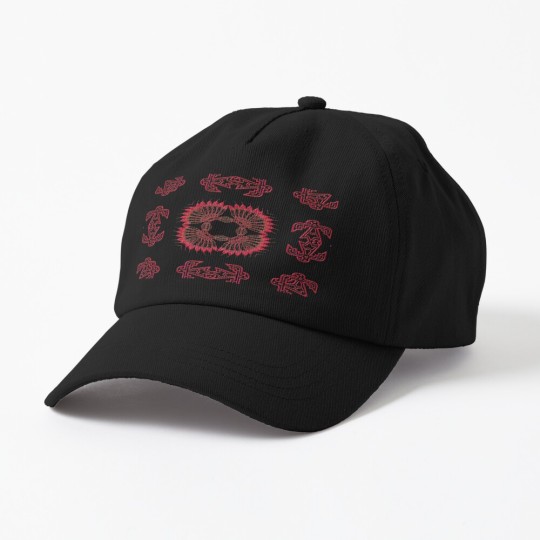

(via "UNIQUE RED NATIVE AMERICAN ART CHIEF HEADDRESS EAGLE TOTEM PATTERN " Graphic T-Shirt for Sale by Frantz CIALEC)
#findyourthing#redbubble#raleksd#artvsartist#the tribal chief#indigenous#nativeamericans#native indians#native#native american headdress#navajo#sioux#warrior#apaches#tribal art#feathers#totem#birds#eagles
1 note
·
View note